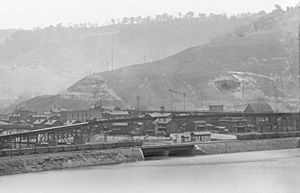Port Perry, Pennsylvania facts for kids
Quick facts for kids
Port Perry, Pennsylvania
|
|
|---|---|

Port Perry from across the Monongahela River, between 1900 and 1915
|
|
| Country | United States |
| State | Pennsylvania |
| County | Allegheny |
| Township | North Versailles |
| Founded | 1790s |
| Founded by | John Perry |
| Elevation | 774 ft (236 m) |
| GNIS feature ID | 1204437 |
Port Perry was a small town in Pennsylvania. It was located along the Monongahela River, close to Braddock, Pennsylvania. It was also near where Turtle Creek flows into the river. By 1945, the town had completely disappeared. It was slowly replaced by many railroad tracks. These tracks were built to serve the huge Edgar Thomson Steel Works nearby.
Contents
History of Port Perry
Founding the Town
The town of Port Perry was started in the 1790s. A man named John Perry founded it. On June 1, 1795, John Perry advertised his "new town." He said it was a great spot because it was near roads, mills, and stone quarries. He also claimed its harbor was "the best on the western waters."
Early Days and Slow Growth
In 1802, a book called The Navigator referred to the settlement as Perrystown. A later edition of the book said that the town near Turtle Creek had "not progressed." This means it hadn't grown much. In 1840, only eight families were reported to live there.
Growth and Development
Port Perry finally started to grow about 50 years after it was founded.
New Structures and Businesses
The original Monongahela Lock and Dam No. 2 was built next to the town. It opened in 1841. A man named Col. William L. Miller, who lived on a nearby hill, re-planned the town. He opened a store that sold boat supplies. This store also worked like a post office before an official one opened in 1850.
Railroads Arrive
The Pittsburgh and Connellsville Railroad laid the first railroad tracks through Port Perry in 1857. This train line reached Pittsburgh by 1861. In the 1860s, Col. Miller's son, George T. Miller, ran a boatyard. This yard built about half of the coal boats used on the river. He also had a sawmill that made about two million gun stocks for the Civil War.
Not an Independent Town
Even when Port Perry was at its busiest, it was never its own city or town. It was always part of a larger area. It was under the control of Versailles Township until 1869. After that, it became part of North Versailles Township.
Decline and Disappearance
The building of the Edgar Thomson Steel Works in the 1870s led to Port Perry's end. This large steel mill was built across Turtle Creek.
Steel Mill Expansion
As the steel mill grew, it needed more space for railroad tracks and yards. Over many years, properties in Port Perry were bought and torn down to make room for these tracks.
Other Factors in Decline
Other things also caused the town to shrink. Coal mines nearby started to run out of coal in the late 1800s. Also, the locks and dam were moved downriver to Braddock in the early 1900s. In 1904, a newspaper called the Pittsburgh Gazette wrote that Port Perry was "passing away."
Rail and River Traffic
Even though its population was shrinking, Port Perry remained a very busy place for trains and river boats. In 1914, articles in trade magazines said that more freight passed through Port Perry than any other place in the world. Four different railroads ran through the town:
- The Pittsburgh, McKeesport and Youghiogheny Railroad
- The Baltimore and Ohio Railroad
- The Union Railroad
- The Port Perry Branch of the Pennsylvania Railroad
Final Years
The steel mill kept expanding, and more railroad tracks were added. This made the town even more crowded and cut off from other communities. After a big expansion of the mill in 1923, Port Perry was almost completely isolated. The very last house in the town was torn down in 1944.


